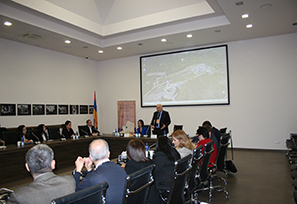20.04.2022

A three-day conference organized by the Armenian Genocide Museum-Institute Foundation and titled
“Challenges of Teaching the Armenian Genocide in the 21st Century” was launched today in its conference hall.
AGMI Director Harutyun Marutyan made the opening speech, saying, among other things:
“We have realised that there is a problem, in terms of methodology, for teachers and ourselves and this conference is called upon to address it. This is probably the first such conference in the Armenian reality. Through discussions with authoritative scholars from abroad, we want to get an idea of how the subject of genocide is taught in foreign countries in both Armenian and non-Armenian environments, given the fact that the foreign experts here represent mainly nations that have been subject to genocide at different times.”
Deputy Minister of the RA Ministry of Education, Science, Culture and Sports Janna Andreasyan made a welcoming speech and said:
“This conference, dedicated to the challenges of teaching the topic of genocide in general education institutions, is more than relevant today. Let's hope that this examination will not be too late. There will also be a discussion that will allow us to have a clearer idea of the best strategies to use for teaching the subject in the face of the challenges we have today.”
The conference opening ceremony was followed by the opening of a temporary exhibition titled
“Tracing the Armenian Schools in the Ottoman Empire: An Enlighted Nation’s Certificates” organised by the Armenian Genocide Museum-Institute Foundation, the aim of which is to raise and present, from a distance of more than a century, the once fruitful activity of about 2000 Armenian schools in western Armenia, Cilicia and the Armenian-populated areas of the Ottoman Empire, which was interrupted by the Armenian Genocide.
Those institutions, despite the persecution and violence perpetrated by the Ottoman government, not only did not cease to exist, but also had great success for decades, making significant contributions to the empire's education, science, and cultural development.
The exhibition was opened with speeches made by Harutyun Marutyan, Director of the Armenian Genocide Museum-Institute Foundation, and by Seda Parsamyan, who is responsible for organising AGMI exhibitions.
In his speech, the AGMI director said:
“Armenians, despite not having a government and constantly being persecuted by the Ottomans, nevertheless managed to have a well-developed educational system in the Ottoman Empire, as you will see in our new temporary exhibition.”
Seda Parsamyan said:
“The exhibition provides an opportunity to obtain an idea not just about the given institution’s activities, teaching methods, students and teaching staff, subjects taught and other issues from a distance of more than a century, but also brings up a wide range of issues related to the Western Armenian school, educational work and education system.”
The temporary bilingual exhibition consisting of sixteen panels (in Armenian and English) present about thirty original graduation certificates, as well as photographs, textbooks and school supplies which were obtained from the archives, museums and libraries of various institutions in Armenia and the diaspora, as well as from private collections.
The original certificates presented include more than a dozen held in the collections of the Armenian Genocide Museum-Institute, as well as rich accompanying documentary material, which provide factual evidence of the former existence of Armenian schools in the Ottoman Empire.
The exhibition includes certificates from such well-known Western Armenian schools such as Karin’s (Erzerum) “Sanasarian” (1881-1915), Van’s “Yeramian” (1878-1915) and “Vaspurakan Central” (1881), Kharberd’s “Community Central/Tlkatintsi” (1887-1915), Sebastia’s “Aramian” (1895-1914), Aintap’s Community “Haykanushian” (1877-1915), Caesarea’s (Kayseri) “Kumshian” (1826-1915) and others.
A separate section of the exhibition is dedicated to Constantinople’s Armenian schools, where famous western Armenian intellectuals, who were victims of the Armenian Genocide, had studied. Some of the graduation certificates belonged to well-known western Armenian intellectuals such as Ruben Sevak, Daniel Varujan, Misak Metsarents (Metsaturian), Tadeos Mankasarian and Rafael Shishmanian.
The missionary schools in the Ottoman Empire are also presented in a separate section: the “Armenia” later “Euphrates” College (1878-1915) in Kharbert, the “Hayuheats” High School (1885-1915) of Aintap and Adabazar, St. Paul’s Institute of Tarson (Tarsus) (1888-1915), the Partizak High School, Sebastia’s American Teachers’ “Normal School” (1880-1915) and the Teachers’ College (1912-1915), in which Armenian students made up a significant number.
In addition to the students in community schools, there were a large number of Armenians in imperial state institutions, some of whose certificates are included in this exhibition.
The temporary exhibition and the conference were funded by the Ministry of Education, Science, Culture and Sports and the Science Committee of the Republic of Armenia.
The exhibition will be open until September 10, 2022.





